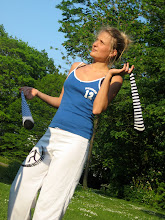The first day we spent at the project, which consists of no more than four LITTLE rooms with a grassfield in front, I got an idea of the working circumstances in the project here in Ecuador. Ellen and I were by ourselves - as it was still carnaval, the children stayed at home.
The next day, it was quite different - as soon as we arrived, LOTS of children hustled into the playing and learning place, hugging me (even as a stranger) immediately and wanting to play. Some children called for attention more expressively -others more shyly- but all of them obviously, only through their fierce and hopeful look in their eyes.
The project hosts up to 140 (!) children, usually there are around 70 attending during each day.
The youngest are only two years old, the oldest are 15 , some of them helping actively to give company to the younger. Most of the children are between 6 and 12.
They come to the project to play, distract themselves, eat a good meal- but also to learn: They learn about hygiene (washing their hands before entering the rooms, brushing their teeth after the food) but the educators also treat typical school topics with the children - helping the ones that go to school with homework etc.
There are only 3 native teachers, besides the North American directrice Ella, who gives classes to the elder ones. One psycologist, one volunteer and Ellen as a drama therapist join the team at the moment. They hope to get supported by two German psycologists soon, as well as some more volunteers, like they used to have before.
As you can imagine, there can be quite a chaotic atmosphere. When we were there with the children one teacher had to give class in the little, little kitchen, where two big pots of rice and beans were boiling on a hot gas stove; the huge flames heating the whole room instantly.


It is very surprising to see how calm the teacher stayed, how concentrated the children (apart from some exceptions of course) worked on little drawings of the Ecuatorian flag. A typical task for children, it is natural to stimulate national consciene - I have seen this in Honduras very often. Also I recognized that all the children were longing for using a ruler. It is not easy for them to create a straight line, yet very important - even for drawing the flag, that could imaginably float in the wind without no straight line. As an art therapist I would analyse the fight for the few rulers that were accessible as some big necessity for structure and control. It makes sense, when children come from a surrounding where they are mostly left by themselves, having to create their own structure and rules of life.







Hallo Johanna,
ReplyDeleteGreat to read about your travellling and work across the ocean! Say hello to Ellen.
I really like you both doing these activities!
Groetjes van Wietske
from Stenden University Leeuwarden Netherlands